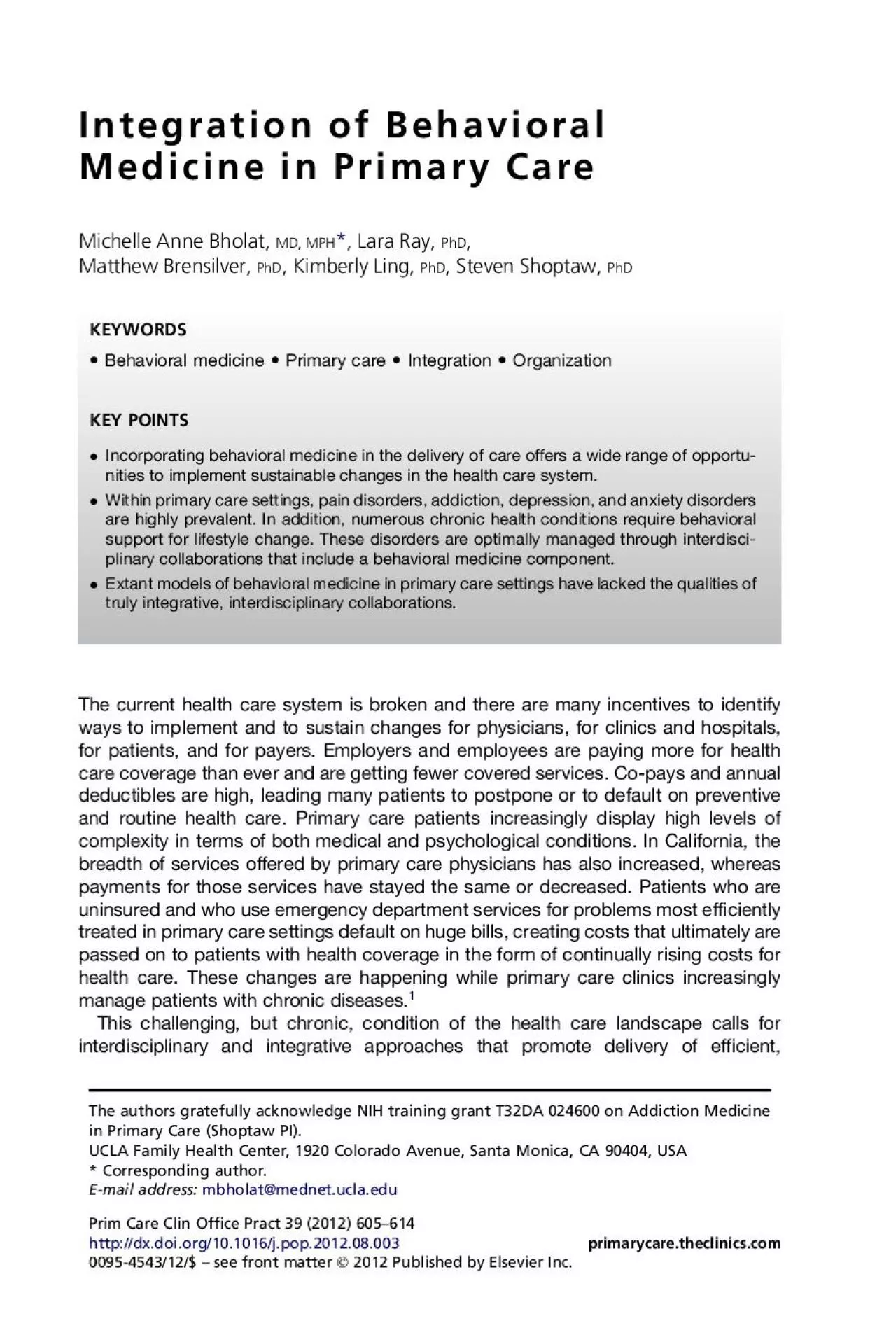

TheauthorsgratefullyacknowledgeNIHtraininggrantT32DA024600onAddictionMedicineinPrimaryCareShoptawPIUCLAFamilyHealthCenter1920ColoradoAvenueSantaMonicaCA90404USACorrespondingauthorEmailaddres ID: 937524
Download Pdf The PPT/PDF document "IntegrationofBehavioralMedicineinPrimary..." is the property of its rightful owner. Permission is granted to download and print the materials on this web site for personal, non-commercial use only, and to display it on your personal computer provided you do not modify the materials and that you retain all copyright notices contained in the materials. By downloading content from our website, you accept the terms of this agreement.
IntegrationofBehavioralMedicineinPrimaryCareMichelleAnneBholat,MD,MPH,LaraRay,MatthewBrensilver,,KimberlyLing,,StevenShoptaw,Thecurrenthealthcaresystemisbrokenandtherearemanyincentivestoidentifywaystoimplementandtosustainchangesforphysicians,forclinicsandhospitals,forpatients,andforpayers.Employersandemployeesarepayingmoreforhealthcarecoveragethaneverandaregettingfewercoveredservices.Co-paysandannualdeductiblesarehigh,leadingmanypatientstopostponeortodefaultonpreventiveandroutinehealthcare.Primarycarepatientsincreasinglydisplayhighlevelsofcomplexityintermsofbothmedicalandpsychologicalconditions.InCalifornia,thebreadthofservicesofferedbyprimarycarephysicianshasalsoincreased,whereaspaymentsforthoseserviceshavestayedthesameordecreased.Patientswhoareuninsuredandwhouseemergencydepartmentservicesforproblemsmostefficientlytreatedinprimarycaresettingsdefaultonhugebills,creatingcoststhatultimatelyarepassedontopatientswithhealthcoverageintheformofcontinuallyrisingcostsforhealthcare.Thesechangesarehappeningwhileprimarycareclinicsincreasinglymanagepatientswithchronicdiseases.Thischallenging,butchronic,conditionofthehealthcarelandscapecallsforinterdisciplinaryandintegrativeapproachesthatpromotedeliveryofefficient, TheauthorsgratefullyacknowledgeNIHtraininggrantT32DA024600onAddictionMedicineinPrimaryCare(ShoptawPI).UCLAFamilyHealthCenter,1920ColoradoAvenue,SantaMonica,CA90404,USA*Correspondingauthor.E-mailaddress:mbholat@mednet.ucla.edu BehavioralmedicinePrimarycareKEYPOINTSIncorporatingbehavioralmedicineinthedeliveryofcareoffersawiderangeofopportu-nitiestoimplementsustainablechangesinthehealthcaresystem.Withinprimarycaresettings,paindisorders,addiction,depression,andanxietydisordersarehighlyprevalent.Inaddition,numerouschronichealthconditionsrequirebehavioralsupportforlifestylechange.Thesedisordersareoptimallymanagedthroughinterdisci-plinarycollaborationsthatincludeabehavioralmedicinecomponent.Extantmodelsofbehavioralmedicineinprimarycaresettingshavelackedthequalitiesoftrulyintegrative,interdisciplinarycollaborations.PrimCareClinOfficePract39(2012)605–614http://dx.doi.org/10.1016/j.pop.2012.08.003primarycare.theclinics.com0095-4543/12/$–seefrontmatter2012PublishedbyElsevierInc. cost-effective,andhigh-qualitymedicalcare.Nomedicationcancurechronicdiseases.Instead,behaviorchangeisrequiredtomanagetheimpactsofchronicdiseasesonanongoingbasis.Integrationofbehavioralmedicineandprimarycarerepresentsanalternativetodeliveringcomprehensive,high-qualitycaretopatients,and,indoingso,forgesnewrelationshipswithinthehealthcareteamandadministra-tiveleadership.However,fewmodelsexisttoguidetheintegrationofthisteam-basedapproachintoprimarycaresettings,inwhichthepredominantmodelconsistsofcarebeingdeliveredbytheindividualprovider.Thisarticlereviewstherationaleforunder-takingtheintegrationofbehavioralmedicineinprimarycare
anddescribestheexpe-rienceoftheUCLAFamilyHealthCenterinintegratingbehavioralmedicineintoanurban,primarycare,patient-centeredmedicalhomethatprovidesservicestoamixofinsuredandunderinsuredpatients.RATIONALEAspatientsincreasinglypresenttoprimarycarewithchronicconditions,theyrequiremorethanprescriptionsfromtheirdoctorstoteachandmaintainpositivehealthoutcomes.Giventimeconstraints,theseneedsarebestaddressedbyaninterdisci-plinaryteamthathasanexplicitfocusonprescribingmedicationsinthecontextofsus-tainedbehaviorchange.Theteamcanextendthephysicianbyfocusingonbehavioraldomainsthatrangefrommedicationadherencetolifestylefactors(dietarychanges,exercise)tobehavioralcareapproachesformentalhealth,addiction,andpaindisordersthatarebothhighlyprevalentandcomorbidwithotherchronicillnesses.Showingthatprimarycarecanbreachthegap,generalmedicalcaresettingsnowrepresentanimportantsectorforthetreatmentofmentalhealthdisorders.Forexample,carefordepressioningeneralmedicalpracticemorethandoubledinacomparisonofdatafrom1990to1992and2001to2003.Further,exclusivereli-anceongeneralmedicalproviderswithoutsupportfromapsychiatristormentalhealthspecialistincreasedby153%duringthesameperiod.Asimilarpatternmaybedevelopingregardingthetreatmentofaddictions,withtherecentapprovalofapaletteofmedications.Aswithmentalillness,substanceabusedisordersarehighlyprevalent.Anestimated22.1millionAmericanshavesubstanceabuseordependence,exceptingtobaccodependence,withmorethantwo-thirdsofthesevisitingprimarycaredoctorsregularly.Theincreasedaccesstomentalhealthservicesinprimarycarecoupledwiththedecreasedstigmaofseekingtreatmentofasubstancedisorderand/ormentalillnessinthesesettingsiscriticaltoreachingindi-vidualsaffectedbytheseillnesses.Thispointisparticularlyrelevantbecausetheconsequencesofaddictionsandmentalillnessaredisproportionateforthoselivingwitheconomicandhealthcaredisparities.Theprimarycaresettingalsoallowsforadevelopmentallifespanapproachtoiden-tifyingandtreatingmild-to-moderatementalhealthandaddictiondisorders.Adoles-centsandyoungadultsaremorelikelytousesubstancesthanallotheragewiththeincidenceofdrugabuseanddependencedisorderspeakingatages19to25years.Thispatterncoincideswithinitialonsetofmajormentalillnesses.Tothatend,primarycarecliniciansareinauniquepositiontoservesentinelandearlyinterventionfunctions.Acrossthelifespan,alcoholanddrugproblemscanemergewhenpatientsusethesesubstancestocopewithfamilyproblems,chronicpain,andeconomichardships,whicharesituationsthatalsoaredetectablebyprimarycarephysicians.Concernsaboutsubstanceusenolongerremitwithadvancedage,becauseolderadults(babyboomers)arenowagingup,butnotout,ofsubstanceuse,particularlymarijuana.Again,theprimarycareclinicrepresentsBholatetal anidealsettingforidentifyingandtreatingmild-to-moderatemetalhealthproblems,includingsubstancemisuse.Severalphysicalandorganizationalfactorsservetomaintainseparatesi
losforprimarymedicalcare,substanceabusetreatment,andmentalhealthcare.Thereisnosystematicapproachtoprovidingbehavioralhealthinprimarycaresettingsand,without1ormorebehavioralhealthspecialistsandphysicianchampionstoadvocatechange,theinertiaofthestatusquooftenprevails.Concernsoverbillingandreimburse-mentforbehavioralhealthservicespredominatebecauseprimarycareclinicsoperateontightmarginsthatprecludeprovidingservicesthatarenot(atleast)budgetneutral.Physicianstypicallyavoiddiscussionsaboutaddictionwiththeirpatients,believingtheremaynotbemuchtheycandotohelp,whichmayreflectstigmaandinadequateAnotableexceptionistheincreasingwillingnessofphysicianstodiscusstobaccosmokingandcessation.Theneedforintegratingbehavioralhealthintoprimarycareisgreat.Theprevalenceofmentalhealthoraddictiondisordersinprimarycareishighandincreasessubstantiallywhenfactoringinmentalhealth,addiction,orpaindisordersthatarecomorbidtochronicdiseases.Thisarticlereviewstheprevalenceofthesedisorderswithafocusonprimarycaresettings.DepressionandAnxietyDepressionandanxietydisordersarecommoninprimarycare.Inalargerepresenta-tivesampleofUSadults,26.2%hadatleast1past-yearmentaldisorder,withanxiety(18.1%)andmooddisorders(9.5%)figuringmostprominently.Inprimarycareprac-tices,depressionordysthymiadiagnoseswereobservedin27%to29%ofpatients;anxietydisorderswereobservedin19%to26%ofpatients.13–15Thesefiguresarestrikinggiventhatonly5%ofpatientsvisitedtheirproviderforapsychiatriccomplaintandthatmostpatientswithcurrentdepressivedisordersdonotreceivementalhealthtreatment.Depressionalsoiscommonlycomorbidtodiabetesmellitus,tocoronaryarterydisease,andtostroke.Untreateddepressionisassociatedwithdifficultiesinaccessingprimarycareandobtainingcomprehensiveservices;2criticalmarkersofqualityofcare.Tothatend,thecostofcarefordepressedolderadultsissignificantlyincreasedforbothambulatoryandinpatientservices.Itiscommonlyacceptedthatdepressionisadistinguishingfeatureofhighusersofmedicalservices.About1in11Americanadultsolderthan12yearsmetcriteriaforsubstanceabuseor;alcoholabuseanddependencerepresentmostcases(17.9million;7.0%ofadultsand81%ofthetotalsubstanceabuse/dependencepopulation).Heavyalcoholuseisassociatedwithahugepublichealthburdenandmost(70%–80%)individualswithproblematicdrinkinganddrugabusedonotseektreatment.careclinicshavebeenidentifiedasanimportantresourceinusingScreening,BriefInterventions,ReferraltoTreatment(SBIRT)procedurestoidentifyandtomakeappropriatedispositionsofcasesbasedonlevelsofuseornonuse.Agrowingnumberofmedicationsforaddictivedisorders,whoseefficacyisboostedbyprovidingshort-termbehavioraltherapies,areavailableforuseinoutpatientsettings(Table1Inadditiontoidentifyingpatientswithaddictionproblemsinprimarycaresettings,interventionwithmild-to-moderatecasesmayreducestigmaandcircumventbarrierstotreatmentsinindividualswhowouldbeunlikelytoseekcareataspec
ialtyclinic.BehavioralMedicineinPrimaryCare showingnoimprovementorcontinueddeteriorationoffunctioningaveraged2orfewersessions.Successfulimplementationofabehavioralmedicineclinicwithinanurbanfamilymedicineteaching/innovationcenterinauniversitymedicaldepartmentrequiredcoordinationofindividual,group,andorganizationalinterests.In2005,theacademicrolesofaddictionandbehavioralmedicineexpertisewereintegratedintotheFamilyMedicinedepartment.In2006,theteamconductedaclinicaltrialwithintheprimarycareclinic,integratingtheacademicresearchgroupwiththeprimarycareclinicteam.In2008,additionalinstitutionalsupportwasgainedbycolocatingaddictionmedicine,behavioralmedicine,pain,andpalliativecareintheFamilyMedicinedepart-ment.In2009,thebehavioralandaddictionmedicineserviceswereofferedtopatients.Inaddition,aNationalInstituteofHealthtraininggrantforfellowsandpost-doctoraltraineesaswellasapracticumforadvancedclinicalpsychologygraduatestudentswereestablished,providingtrainingopportunitiesandfoundationsforresearch.Astheclinicdeveloped,standardizedproceduresweredevelopedtoassistthecoordinationandintegrationoftheprimarycareandbehavioralmedicine.Innova-tionswereintroducedandtestedusingRapidCycleImprovementPlan-Do-Study-Actmethodologytoimplementchangesquickly,receivefeedback,andreviseproce-dures.Standardizedchartsandmeasureswereusedtoreduceredundanciesandincreaseconsistencyininformation.Briefmeetingsorhuddleswereinstitutedatthebeginningofeachclinicdaytoquicklyreviewup-to-the-minutepatientneeds,includingensuringcoordinationwhenpatientswereseeingmultiplecareproviders,confirmingthatnewpatientswereprovidedwiththeappropriateprevisitmaterialsandintroducedtoallmembersoftheteam,andmakingcertainthatpatientsdis-chargedfromthebehavioralcareteamwerereceivingappropriateandtimelyaccesstofollow-upcare.Oneadditionalmarkerofsuccesswasthatthebehavioralmedicinereachedfinancialviabilityin2010,1yearafterimplementation.LESSONSLEARNEDAtthispoint,behavioralmedicineisacost-effectiveadditiontoanurbananduniversity-basedfamilymedicinepractice.Inadditiontobeingwell-receivedbypatientsandcliniciansalike,therearemultiplesignsthatintegrationofbehavioralmedicinehasimpactedtheclinic:(1)staffmembersrecognizethat(forthemostpart)patientsenrolledinbehavioralmedicinegetbetter,asmarkedbyreductionsinno-shows/cancellations;(2)teamtreatmentconceptsarespreading,andthehuddleinitiallylinkedtobehavioralmedicineisnowusedwithadditionalteammemberswithintheclinic;(3)increasedandfocusedcommunicationaboutbehavioralscienceandthewaysitcanbeusedbyallmembersoftheteamhasreducedtheoverallnumberofepisodeswithdifficultpatientsrequiringattentionfromthemedicalstafforpolice.Althoughthebehavioralmedicineclinicisaworkinprogress,therearemoresuccessesthanfailuresatthelevelofthepatients,oftheclinicalteam,andofthebottomline.ThisexampleofintegratingbehavioralmedicineintoprimarycareatUCLAmaynotgener
alizetoallprimarycaresettings.Theassemblageofchampionsinadministra-tion,skilledbehavioralspecialists,andsupportiveteammemberswillingtoworktowardfinancialviabilitymaybeuncommon.Inthoseclinicswherechampionsinadministration,skilledbehavioralspecialists,andsupportiveteammembersarecolo-cated,frontofficestaffandotherprovidersandadministratorsmayrequiretimetoadjusttocaredeliverythatdeviatesfromtheindividualprovidermodel.Inaddition,BehavioralMedicineinPrimaryCare AUNIFIEDBEHAVIORALMEDICINESERVICE:CASEEXAMPLEInJanuary2009,ourteamintegratedbehavioralmedicineintotheUCLAFamilyHealthCenter(UFHC).Inthebehavioralmedicineclinic,patientsreceivecarefromamultidis-ciplinaryteamthatmayincludetheirreferringfamilyphysician,anaddictionmedicinespecialist,apainmanagementspecialist(ifrequired),andabehavioralmedicinespecialist,whichresultsincoordinationofprimarycare,pharmacotherapy(formedical,psychological,andpainconditions),brief(5–8weeks)behavioraltreatment,andassessmentandtreatment(orreferral)forsubstanceabusein1facility.Commu-nicationisfacilitatedbyahuddlebeforetheweeklybehavioralmedicineclinictocoor-dinateconcernsregardingsharedpatientswithfrontandbackofficestaff,physician,andclinicmanagersandcreatesintegratedtreatmentplanstobestsupportthepatient.Inbetweentheclinicvisits,thepatient-centeredmedicalhometeammeetsviateleconferenceeveryotherweekfor60minutestoreviewcasesthatrequirefurtherdiscussionandasfrequentlyasneededtoaddressurgentissues.Alltreatmentsdeliveredbythebehavioralmedicineclinicareshortterm,averaging5to8sessions,andaredeliveredusingevidence-basedmodels.Althoughevidence-basedmodelsareused,flexibility(ie,practicalcounseling)guidesthedeliveryoftheseinterventions.Thisflexibilityisessentialgiventhecomplexclinicalpresentationsthataretypical.Aunitary,focusedapproachdictatedbyasingletreatmentmanualgener-allyfailstoaddressthediverseneedsofpatientsseeninourclinic.Forexample,behaviortreatmentmanualsoftenfailtoaccountformedicationcomplianceandothermedicalhealthindicesthatarecrucialtotheprimarycaresetting.Inadditiontotheinterplayofchronicdiseasesmanyofourpatientspresentwith,morethanasinglepsychiatricdiagnosisiscommon,apatternfoundinnationallyrepresentativeThereisadearthofevidencetoguidedecisionsregardingadaptationofevidence-basedpsychosocialtreatmentstocomplexcases,leavingthecliniciantaskedwithtailoringtheinterventiontotheclient’spresentation.Theclinicianmayselectaspecificevidence-basedinterventionforthepresentingconcern,butelementsofotherempiricallyvalidatedtreatmentmodelsareoftengraftedontotheprimaryintervention.Forexample,casemanagementisusuallyrequiredtocoordinatecareandtoavoidduplicationbetweenproviders.Aspatientscompleteacourseoftreatmentwiththebehavioralmedicineclinic,thereferringphysicianisroutinelyprovidedwithrecommendationsforongoingmanagementtosustain,andperhapsenhance,gains.Allbehavioralmedicineservi
cesareprovidedunderthedirectsuper-visionoflicensedclinicalpsychologists.Consistentwithanattendingmodelofcare,theattendingclinicalpsychologistsjointhemaster’s-levelcliniciansforaportionofeachvisit,toensurethatthetreatmentgoalswereappropriatelyidentifiedandthattherecommendedinterventionswereimplementedflexiblyandeffectively.Treatmentisbrief,withtheinitialcontracttypicallybeing5sessionsfollowingtheinitialassessment.Assignaledearlier,theprimaryobjectiveforthepatientisimprovedfunctioning(ie,avoidingemergencymedicalcare,abilitytoreturntowork);improve-mentsinmoodandaffectaredesirable,butaresecondary.Thisfocushelpsclinicianstoavoiddriftintreatmentandtofocusonrelievingimpairmentsfrompresentingsymp-toms.Althoughfeaturesofpersonalitydisordersareprominentinmanyofourpatients,wedonotdirectlychallengethesetraitsandinsteadseekprogressonthepresentingcomplaintsandreinforcepatients’progresstowardhealth.Whereappro-priate,patientswhomaybenefitarereferredforlonger-termcare.Preliminaryqualita-tivedatafrominitialpatientstreatedshowthatsessionattendancecorrespondswithimprovementsinoverallclinicalratingssuchthatthosewhowereratedasmildlytomoderatelyimprovedaveraged6to8sessions,whereasthosewhowereratedasBholatetal thepatienttotheprimarycareprovider).Fullintegrationrequiressupportfromleader-shipduringtheintroductionoftheservices,whilealsoretainingperspectiveoverthelongtermasthesystemaccommodatestoserviceprovisionandbeginstoexperienceitsbenefitsanduniquechallenges.Atallstages,fromintroductiontoconsolidationtomaintenance,afullyintegratedmodelofbehavioralhealthinprimarycarerequiresformalizedregularcommunication,carecoordination,andcasemanagementbetweenprimarycarephysicians,thebehavioralspecialist,andthesupportofthehealthcareteam,whichincludesbothfrontandbackofficestaffmembers.Problemsthatarisewhenintegratingbehavioralhealthintoprimarycareoftensignalinadequate,unclear,orinsufficientlevelsofcommunicationbetweenphysicians,nurses/backofficestaff,behavioralspecialists,andadministrativesupportstaff.Onemechanismforcommunicatinginmultidisci-plinaryorteampracticesettingsisahuddle,oraperiodbeforeclinicwhenallmembersoftheteammeetbrieflytoshareinformationaboutpatientsonthescheduletopreparetheteamforcasesthatmayneedextraattentionorsupport.Communica-tionusingabriefconsultorane-mailregardingthediagnosisandexpectedtreatmentplanforapatientaidscasecoordinationandteambuilding.Preparationofadischargesummarybythebehavioralmedicineteam,whichiscompletewithconcretebehav-ioralrecommendationsthatcanhelptheprimarycarephysicianevaluateandsupporthealthybehaviorchange,isessential.Developingmethodsforfrequentformalandinformalcommunicationbetweenteammembersfacilitatessmootheroperationswhenintegratingbehavioralmedicineintoprimarycare.Adequateforethoughtmustbegiventothedocumentationofbehavioralhealthservicesinrelationtothepatient’smedicalrecord
.Additionalprivacyissuesrequireconsiderationwhendocumentingcare,particularlyincasesinwhichmentalhealthandsubstanceabusediagnosesareinvolved,becausetheseinvokehigherlevelsofrequirementsforprivacyandrestrictionsonwhocanaccessprogressnotesorotherdocumentation.Privacyissuesareparticularlyimportantinclinicsettingsthathavealreadymigratedfrompaperchartstoelectronichealthrecords.Aseparationofbehavioralmedicinerecordsfrommedicalrecordsmayberecommendedtomeettherequirementsforconfidentialityassociatedwithmentalhealthrecords.Itisimportantthattheorganizationaddresseshowkeyinformationsuchasacompletemedicationlistthatincludespsychiatricandaddictionmedications,aswellasaccesstobehav-ioralhealthrecordsbyneed-to-knowmedicalstaff,mustbeadequatelyaddressedbyexecutiveleadershiptoensuresafeandeffectivemedicalcaretothepatient.Atthestartandperiodicallyafterward,considerationofclinicformsandpatientregistrieswithoutcomemeasuresandmetricsforassessingprogressisessential.Documentsforlegalandbillingpurposeslikelyexistandrequireminoralterations,includingconsent/assentdocuments,releasesofinformation,agreementsregardingbilling,chargedocuments,treatmentplans,progressnotes,anddischargesumma-ries.Further,validandreliablebehavioralmedicinedomainmeasurementsareavail-able.Thesemeasuresincludedomainsofsomaticcomplaints,depressionandanxietysymptoms,functionalimpairment,andqualityoflife.Behavioralmarkerslikelyhavethemostprofoundstrengthinshowingchangesthatcorrespondwithprovisionofbehavioralmedicineservices.Thesemarkersincludenumberofvisitstohigh-intensitymedicalcaresettingsbeforeandafterbehavioralmedicineservicesaredeliv-ered(eg,emergencydepartments,hospital),percentarrivaltoscheduledprimarycareappointmentsbeforeandfollowingbehavioralmedicineservices,andnumberofsessionsattendedduringbehavioralmedicinetreatment.Settingsthathaveaccesstoelectronicmedicalrecordscanmoreeasilygathersomeofthesemetrics,whereasothersmayrequiretheadditionofpaper-and-pencil(orcomputerized)instruments.BehavioralMedicineinPrimaryCare Chronicnoncancerpain(typicallydefinedaspainpersistinglongerthan3months)affectsalargeproportionofthepopulation.Prevalenceisestimatedtobeapproxi-mately20%,althoughrepresentativesurveysfindratesexceeding30%.theprevalenceandburdenofchronicpainhasbeenmorefullyrecognized,thelast2decadeshaveseenlargeincreasesinopioidprescribingrates,resultinginanesti-mated10millionAmericanscurrentlyreceivingchronicopioidtreatment.Thoseatincreasedriskforprescribedopioidmisuseincludeindividualswithcomorbidpsychi-atricdisorders,youngerindividuals,andthosewithpriorsubstanceabuseprob-Annualdirectmedicalexpenditureisinthetensofbillionsofdollars,associatedlossesineconomicproductivityestimatedinexcessof$60billion.lowbackpain,forexample,primarycarecostsrepresent13%ofdirectmedicalexpenditures,comparablewithinpatientservices(17%)andpharmacy(13%).Behavioralinterventionsta
rgetingfunctionalimpairmentanddepressivesymptomsassociatedwithchronicpainhavebeenadvancedasmeansofaddressingthispublichealthburden.Thesefigureshighlightthepotentialvalueofbehavioralmedicineinmitigatingsomeoftheconsequencesandhealthimpactsthatlieattheintersectionofchronicpain,opioidtreatment,andsubstancemisuseoraddiction.INTEGRATIONOFBEHAVIORALMEDICINEINTOPRIMARYCARE:PREPARATIONSMovingfromaprimarycareclinictoapatient-centeredmedicalhomewithaninte-gratedmodelthatincludesbehavioralmedicineasanessentialpartoftheclinictakestime,foresight,andpatience.Intheearlyphase,introducingbehavioralmedicine,withitsfocusonmitigatingimpactsofchronicdiseases,intoanurbanprimarycareclinicrequiresadministrativeandclinicalleadershiptobenotonlyachampion,butabooster.Withtime,goodwillwillbeforthcomingfromnursingstaffandotherclini-cianswhoobservepositiveoutcomesforpatientswhoaccessbehavioralmedicineservices.However,foresightisvital.Executiveleadership’sprospectivedefinitionofthelevelofintegrationforthebehavioralmedicineclinicinprimarycarerangesfromminimal(referpatientsinprimarycaretospecialtyclinics)tobasic(havingbehavioralhealthprovidersclosebyoron-site)toclose(behavioralhealthispartiallyorfullyinte-grated).Fullyintegratedbehavioralhealthinprimarycarecontains(1)screeningforcomorbidconditions,(2)embeddedbehavioralhealthstaff,(3)activelinkingofpatientstoservices,(4)roamingconsultantsoraccessibletelemedicineservicesthatcanaidcasesthatemergeduringclinic,and(5)continuityofcare(ie,returning Table1Evidence-basedmedicationandbehavioraltreatmentsforsubstanceusedisordersMedicationsApprovedforUseSmokingNicotinereplacementtherapy,bupropion,vareniclineOpioidsMethadone,buprenorphine,naltrexoneAlcoholOralandinjectablenaltrexone,acamprosate,disulfiramMethamphetamineStrongsignalforbupropionBehavioralTherapyModelswithEfficacyCognitivebehaviortherapySmoking,opioids,alcohol,stimulantdisordersContingencymanagementStimulantdisordersMotivationalinterviewingSmoking,alcohol,stimulantdisorders12-stepfacilitationAlcoholdisordersBholatetal 30.EdlundMJ,SteffickD,HudsonT,etal.Riskfactorsforclinicallyrecognizedopioidabuseanddependenceamongveteransusingopioidsforchronicnon-cancerpain.Pain2007;129(3):355–62.31.LuoX,PietrobonR,SunX,etal.EstimatesandpatternsofdirecthealthcareexpendituresamongindividualswithbackpainintheUnitedStates.Spine32.StewartWF,RicciJA,CheeE,etal.LostproductivetimeandcostduetocommonpainconditionsintheUSworkforce.JAMA2003;290(18):2443–54.33.DagenaisS,CaroJ,HaldemanS.AsystematicreviewoflowbackpaincostofillnessstudiesintheUnitedStatesandinternationally.SpineJ2008;8(1):8–20.34.EngelCC,VonKorffM,KatonWJ.Backpaininprimarycare:predictorsofhighhealth-carecosts.Pain1996;65(2):197–204.35.KruegerRF,MarkonKE.Reinterpretingcomorbidity:amodel-basedapproachtounderstandingandclassifyingpsychopathology.AnnuRevClinPsychol2006;2
:36.RuscioAM,HolohanDR.Applyingempiricallysupportedtreatmentstocomplexcases:ethical,empirical,andpracticalconsiderations.ClinPsycholSciPractBholatetal 5.KesslerRC,DemlerO,FrankRG,etal.Prevalenceandtreatmentofmentaldisor-ders,1990to2003.NEnglJMed2005;352(24):2515–23.6.WangPS,DemlerO,OlfsonM,etal.ChangingprofilesofservicesectorsusedformentalhealthcareintheUS.AmJPsychiatry2006;163(7):1187.7.WestenD,NovotnyCM,Thompson-BrennerH.Theempiricalstatusofempiricallysupportedpsychotherapies:assumptions,findings,andreportingincontrolledclinicaltrials.PsycholBull2004;130(4):631.8.NationalSurveyonDrugUseandHealth.2011.9.Whitlock,etal.2002.10.SAMHSA.2007.11.Compton,etal.2007.12.SoykaM,GorelickDA.Whyshouldaddictionmedicinebeanattractivefieldforyoungphysicians?Addiction2009;104(2):169–72.13.AnsseauM,DierickM,BuntinkxF,etal.Highprevalenceofmentaldisordersinprimarycare.JAffectDisord2004;78(1):49–55.14.KroenkeK,SpitzerRL,WilliamsJB,etal.Anxietydisordersinprimarycare:prev-alence,impairment,comorbidity,anddetection.AnnInternMed2007;146(5):15.RocaM,GiliM,Garcia-GarciaM,etal.Prevalenceandcomorbidityofcommonmentaldisordersinprimarycare.JAffectDisord2009;119(1–3):52–8.16.Anderson,Freedland,Clouse,etal.2001.17.MusselmanDL,EvansDL,NemeroffCB.Therelationshipofdepressiontocardio-vasculardisease:epidemiology,biology,andtreatment.ArchGenPsychiatry18.BurvillP,JohnsonG,JamrozikK,etal.Prevalenceofdepressionafterstroke:thePerthCommunityStrokeStudy.BrJPsychiatry1995;166(3):320–7.19.DrussBG,RaskK,KatonWJ.Majordepression,depressiontreatmentandqualityofprimarymedicalcare.GenHospPsychiatry2008;30(1):20–5.20.KatonWJ,LinE,RussoJ,etal.Increasedmedicalcostsofapopulation-basedsampleofdepressedelderlypatients.ArchGenPsychiatry2003;60(9):897.21.PearsonSD,KatzelnickDJ,SimonGE,etal.Depressionamonghighutilizersofmedicalcare.JGenInternMed1999;14(8):461–8.22.HarwoodH,HenrickD,FountainD,etal.TheeconomiccostsofalcoholanddrugabuseintheUnitedStates1992.2009.23.MadrasBK,ComptonWM,AvulaD,etal.Screening,briefinterventions,referraltotreatment(SBIRT)forillicitdrugandalcoholuseatmultiplehealthcaresites:comparisonatintakeand6monthslater.DrugAlcoholDepend2009;99(1–3):24.GurejeO,VonKorffM,SimonGE,etal.Persistentpainandwell-being.JAMA25.KernsRD,SellingerJ,GoodinBR.Psychologicaltreatmentofchronicpain.AnnuRevClinPsychol2011;7(1):411–34.26.JohannesCB,LeTK,ZhouX,etal.TheprevalenceofchronicpaininUnitedStatesadults:resultsofaninternet-basedsurvey.JPain2010;11(11):1230–9.27.MunceSE,StewartDE.Genderdifferencesindepressionandchronicpainconditionsinanationalepidemiologicsurvey.Psychosomatics2007;48(5):394–9.28.OkieS.Afloodofopioids,arisingtideofdeaths.NEnglJMed2010;363(21):29.BradenJB,SullivanMD,RayGT,etal.Trendsinlong-termopioidtherapyfornon-cancerpainamongpersonswithahistoryofdepression.GenHospPsychiatryBehavio
ralMedicineinPrimaryCare itisnecessarytorefreshthesoul.Therearemultiplesuccessesalongthewaythatshowtheimportantwaysthatthelivesofpatientswhoreceivebehavioralmedicinecanbeprofoundlychanged(seethecaseexample).CASEEXAMPLE:GERARDOGerardoisamiddle-agedHispanicmanwithparanoidschizophreniaandalcoholdependencewholivesaloneinalow-costcarefacility.Hewasreferredtobehavioralmedicineservicesbecauseofrequiredemergencydepartmenttreatmentfollowingdrinkingbingesevery3to4months.GerardowasreferredtobehavioralmedicineafteritwasdeterminedthathighliverfunctiontestspreventeduseofnaltrexoneforalcoholAtintake,Gerardoandhisclinicianagreedtoworktowardalcoholabstinenceusingcontingencymanagement(ie,anevidence-basedtreatmentthatprovidesfinancialrewardsinexchangeforbiologicorotherobservedmarkersofsubstanceabstinence).ThisdecisionwasmadeafternotingthatGerardoenjoyedattendingAlcoholicsAnon-ymous(AA)meetings;itgavehimsomethingtodoandheenjoyedthestories.However,hissuspiciousnessinterferedwithhimbecomingactivelyinvolvedwiththesocialaspectsoftheprogram.GerardodidnotdrinkondayswhenheattendedtheAAmeetings.Becausethereisnoinexpensivebiomarkerofbingedrinking,wedesignedacontin-gencymanagementschedulethatprovidedGerardowitha$5couponforalocalfastfoodrestaurantinexchangeforasignaturecarddocumentingattendanceatAAmeet-ingson6of7daysperweek.Gerardowasabletomeetthiscriterionquicklyandwithinafewweekswasregularlyattendingmeetingsdaily.Hestoppedbingedrinking.Hedelightedinthereinforcementwhenheexchangedhissignedattendancelogsfora$5giftcoupon.ThebehavioralspecialistnotedthatGerardo’sabilitytoavoidbingedrinkingwasstable.Inalatersession,thetopicofappearanceandhygienewasdis-cussed.ThenextsessionGerardoattendedclinicfreshlyshaved,withanewhaircutandcleanclothes.Afterabout3months,weprovidedareporttothereferringprimarycarephysiciandescribinghowtocontinuethecontingencymanagementschedule,withrecommen-dationsoffadingthereinforcementsassustainedabstinencecontinued.Gerardocontinuestomaintainabstinence.Hisphysicianisdiscussingpotentialtreatmentwithdepotnaltrexoneasaprophylactictobingedrinkinggiventhathenolongerreceivescontingencymanagement.1.BodenheimerT,ChenE,BennettHD.Confrontingthegrowingburdenofchronicdisease:cantheU.S.healthcareworkforcedothejob?HealthAff2009;28(1):2.CroghanTW,BrownJD.Integratingmentalhealthtreatmentintothepatientcenteredmedicalhome.(PreparedbyMathematicaPolicyResearchunderContractNo.HHSA290200900019ITO2.)AHRQPublicationNo.10-0084-EF.Rockville(MD):AgencyforHealthcareResearchandQuality;2010.3.PruittSD,KlapowJC,Epping-JordanJA,etal.Movingbehavioralmedicinetothefrontline:amodelfortheintegrationofbehavioralandmedicalsciencesinprimarycare.ProfPsycholResPr1998;29(3):230.4.KesslerRC,ChiuWT,DemlerO,etal.Prevalence,severity,andcomorbidityof12-monthDSM-IVdisordersintheNationalComorbiditySurveyReplication.ArchGenPsychiatry2005;62(6):617.Bholate